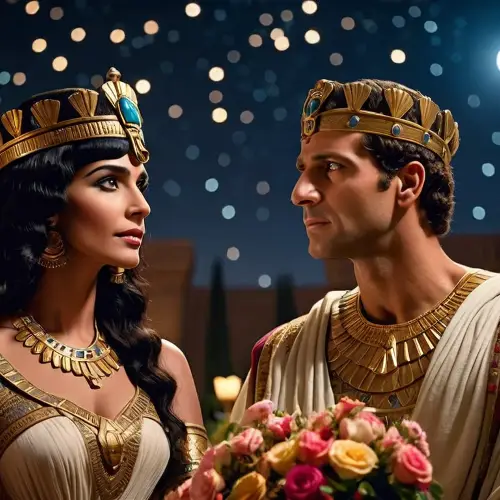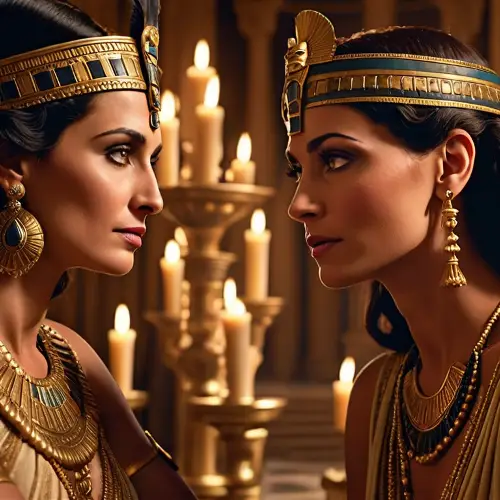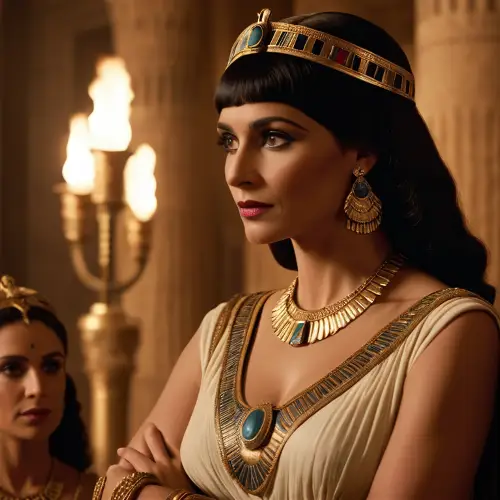In the grandeur of the Egyptian palace, Cleopatra, draped in regal attire, stands beside her young son, Ptolemy XV Philopator Philometor Caesarion. The room, adorned with symbols of ancient Egypt, bears witness to the historic moment as Cleopatra ensures a smooth transition of power.Cleopatras face reflects a mix of maternal pride and sovereign grace as she ceremoniously presents the young heir before the courtiers. The air is charged with the weight of responsibility and the promise of a new reign. The scene captures the essence of a queen securing the future, entrusting her son with the legacy of Egypt.
In the grandeur of the Egyptian palace, Cleopatra, draped in regal attire, stands beside her young son, Ptolemy XV Philopator Philometor Caesarion. The room, adorned with symbols of ancient Egypt, bears witness to the historic moment as Cleopatra ensures a smooth transition of power.Cleopatras face reflects a mix of maternal pride and sovereign grace as she ceremoniously presents the young heir before the courtiers. The air is charged with the weight of responsibility and the promise of a new reign. The scene captures the essence of a queen securing the future, entrusting her son with the legacy of Egypt.
In the grandeur of the Egyptian palace, Cleopatra, draped in regal attire, stands beside her young son, Ptolemy XV Philopator Philometor Caesarion. The room, adorned with symbols of ancient Egypt, bears witness to the historic moment as Cleopatra ensures a smooth transition of power.Cleopatras face reflects a mix of maternal pride and sovereign grace as she ceremoniously presents the young heir before the courtiers. The air is charged with the weight of responsibility and the promise of a new reign. The scene captures the essence of a queen securing the future, entrusting her son with the legacy of Egypt.
Cleopatra, adorned in regal attire, walks through a bustling construction site in the heart of Alexandria. Surrounded by architects and craftsmen, she inspects the progress of a grand edifice taking shape. Dust fills the air as skilled artisans meticulously carve intricate details into stone, bringing her architectural vision to life.The backdrop is a blend of ancient Egyptian motifs and Hellenistic design, reflecting Cleopatras commitment to a harmonious synthesis. The rhythmic sounds of construction echo through the air, and the queen, with a keen eye, offers guidance to ensure the realization of her ambitious architectural endeavor.
Against the backdrop of Cleopatras lavish palace, Julius Caesar and the queen share a moment of intimate connection. Cleopatra, draped in luxurious silks, stands with an air of regal confidence, while Caesar, in Roman attire, is visibly enchanted by her presence.They stand in a sunlit courtyard adorned with exotic flowers and ancient Egyptian sculptures. The soft rustle of palm leaves in the breeze accompanies their conversation, creating a scene where the worlds of Rome and Egypt collide in a harmonious dance of love and intellectual exchange.
Against the backdrop of Cleopatras lavish palace, Julius Caesar and the queen share a moment of intimate connection. Cleopatra, draped in luxurious silks, stands with an air of regal confidence, while Caesar, in Roman attire, is visibly enchanted by her presence.They stand in a sunlit courtyard adorned with exotic flowers and ancient Egyptian sculptures. The soft rustle of palm leaves in the breeze accompanies their conversation, creating a scene where the worlds of Rome and Egypt collide in a harmonious dance of love and intellectual exchange.
Against the backdrop of Cleopatras lavish palace, Julius Caesar and the queen share a moment of intimate connection. Cleopatra, draped in luxurious silks, stands with an air of regal confidence, while Caesar, in Roman attire, is visibly enchanted by her presence.They stand in a sunlit courtyard adorned with exotic flowers and ancient Egyptian sculptures. The soft rustle of palm leaves in the breeze accompanies their conversation, creating a scene where the worlds of Rome and Egypt collide in a harmonious dance of love and intellectual exchange.
In a grand ceremonial hall adorned with symbols of ancient Egypt, Cleopatra, dressed in resplendent attire, ascends to a raised platform. Surrounded by priests, courtiers, and dignitaries, she raises a jeweled scepter, symbolizing her authority, and declares herself the embodiment of Egypts divine essence.The room is bathed in the warm glow of flickering torches, casting a regal aura around Cleopatra. Hieroglyphs and depictions of Egyptian deities adorn the walls, emphasizing the sacred nature of the moment. The assembled crowd bows in reverence as Cleopatra, with unwavering confidence, declares her role as Egypts goddess and pharaoh.
Within the expansive halls of Cleopatras palace, the queen passionately addresses a diverse gathering of scholars, architects, priests, and merchants. Adorned in garments that blend Egyptian and Hellenistic influences, Cleopatra articulates her vision for comprehensive reforms across agriculture, commerce, architecture, and religion.The scene unfolds against the backdrop of an ancient Egyptian setting, with symbols of fertility, trade, and spirituality adorning the surroundings. Maps and architectural plans are spread across tables, illustrating Cleopatras forward-thinking initiatives. The ambiance is one of intellectual exchange and collaboration, symbolizing the queens commitment to advancing her kingdom across multiple domains.
In the resplendent halls of Alexandria, Cleopatra, adorned in regal attire, ascends the throne alongside her son, Ptolemy XV Philopator Philometor Caesarion, a mere thirteen years old. The room, adorned with opulent Egyptian decor, bears witness to the historic moment of succession.Cleopatras face reflects a blend of maternal pride and sovereign determination as she places the diadem on her young sons head. The air is charged with a sense of continuity and the promise of a new era as Cleopatra, with graceful authority, establishes her son as the heir to the throne. The scene captures the essence of a queen securing the legacy of her lineage.
Cleopatra sits in the serene palace garden, gazing up at the dark night sky where stars twinkle in her eyes. On one side stands the Roman Emperor, and on the other, the King of Egypt, both looking towards Cleopatra. Their faces reflect emotions for each other, and in Cleopatra’s hand, there are adorned flowers and a crown. This moment captures a beautiful scene of love and destiny between Cleopatra and the two kings.
In the heart of Alexandria, the echoes of a tumultuous sibling rivalry resound as Ptolemy and Cleopatra find themselves entangled in a fierce dynastic conflict. The palace, once a symbol of unity, becomes the battleground for their internal strife.Ptolemy, fueled by ambition, rallies supporters among the courtiers, while Cleopatra, resolute and strategic, garners alliances to secure her claim. The air is thick with tension as political maneuvers clash with familial bonds, and the once-unified kingdom stands at the precipice of internal discord. The scene captures the poignant moment when familial ties unravel, leaving a kingdom teetering on the brink of internal strife.
In the heart of Alexandria, Cleopatra stands amidst a construction site, adorned in regal attire with architectural plans in hand. Skilled artisans and builders, inspired by her vision, work tirelessly on monumental structures that blend Egyptian and Hellenistic influences.The air resonates with the sounds of chisels and hammers against stone, creating a symphony of progress. Columns rise, adorned with intricate carvings, and grand archways take shape, symbolizing the synthesis of cultures under Cleopatras reign. The scene captures the queens commitment to architectural innovation, as ancient and contemporary elements come together to shape a new era for Egypt.
In the heart of Alexandria, Cleopatra stands amidst a construction site, adorned in regal attire with architectural plans in hand. Skilled artisans and builders, inspired by her vision, work tirelessly on monumental structures that blend Egyptian and Hellenistic influences.The air resonates with the sounds of chisels and hammers against stone, creating a symphony of progress. Columns rise, adorned with intricate carvings, and grand archways take shape, symbolizing the synthesis of cultures under Cleopatras reign. The scene captures the queens commitment to architectural innovation, as ancient and contemporary elements come together to shape a new era for Egypt.
In the heart of Alexandria, Cleopatra stands amidst a construction site, adorned in regal attire with architectural plans in hand. Skilled artisans and builders, inspired by her vision, work tirelessly on monumental structures that blend Egyptian and Hellenistic influences.The air resonates with the sounds of chisels and hammers against stone, creating a symphony of progress. Columns rise, adorned with intricate carvings, and grand archways take shape, symbolizing the synthesis of cultures under Cleopatras reign. The scene captures the queens commitment to architectural innovation, as ancient and contemporary elements come together to shape a new era for Egypt.
In the grandeur of Alexandria, Cleopatra, now 18 years old, stands poised on the precipice of her reign. Adorned in regal attire that blends Egyptian and Hellenistic influences, she exudes an air of confidence and grace beyond her years.The room, rich with symbols of power, bears witness to Cleopatras maturation into a formidable leader. Her eyes, a reflection of wisdom and determination, hint at the challenges and triumphs that lie ahead. The scene captures the young queen on the cusp of her rule, ready to navigate the complexities of governance with both strength and sophistication.
In the opulent halls of Cleopatras palace, Julius Caesar, captivated by the queens enchanting beauty and wisdom, gazes into her eyes with a mixture of admiration and affection. Cleopatra, adorned in resplendent attire, exudes an air of regal grace.The room is bathed in the warm glow of flickering torches, casting a romantic ambiance. As Cleopatra imparts words of wisdom, Caesar listens with rapt attention. The scene captures the intersection of love and intellectual connection, with both figures illuminated against the backdrop of a grand chamber adorned with Egyptian motifs.
In the heart of Cleopatras palace, an intimate observatory comes to life as the queen engages with astronomers and scholars. Bathed in the soft glow of celestial charts and intricate instruments, Cleopatra, donning a headdress reminiscent of stars, passionately discusses advancements in astronomy.The room is adorned with celestial motifs, and telescopes of various sizes point toward the heavens. Cleopatras vision for progress in the field of astronomy is met with animated discussions among scholars, creating an atmosphere of intellectual fervor. The scene reflects the queens commitment to the pursuit of knowledge and the exploration of the cosmos.
In the heart of Cleopatras palace, an intimate observatory comes to life as the queen engages with astronomers and scholars. Bathed in the soft glow of celestial charts and intricate instruments, Cleopatra, donning a headdress reminiscent of stars, passionately discusses advancements in astronomy.The room is adorned with celestial motifs, and telescopes of various sizes point toward the heavens. Cleopatras vision for progress in the field of astronomy is met with animated discussions among scholars, creating an atmosphere of intellectual fervor. The scene reflects the queens commitment to the pursuit of knowledge and the exploration of the cosmos.
In the opulent halls of Cleopatras palace, a momentous occasion unfolds as Cleopatra, radiant in regal attire, stands before a gathered assembly. Her son, Caesarion, stands beside her, the embodiment of a future ruler.Cleopatra, with a proud and loving expression, places a golden crown on Caesarions head, symbolizing his ascent to power. The courtiers and nobles look on with reverence and anticipation. The room is adorned with rich tapestries and intricate Egyptian motifs, echoing the grandeur of the occasion as the young ruler assumes his role under the watchful guidance of his queen mother.
Against the backdrop of Roman opulence, Cleopatra, adorned in resplendent Egyptian attire, engages in a diplomatic dance within the aristocratic circles of Rome. The grand halls echo with the cadence of political discourse as she navigates the complex world of Roman nobility.Cleopatras presence, a fusion of regality and exotic charm, captures the attention of Roman dignitaries. The air is filled with the delicate interplay of diplomacy and intrigue, as the queen strategically forges alliances and cements her influence amidst the marble statues and tapestries of Rome. The scene encapsulates Cleopatras deft maneuvering through the aristocratic tapestry of the Roman elite.
In the heart of Alexandria, Julius Caesar and Cleopatra stand as central figures in a mesmerizing tableau. The opulent surroundings accentuate the magnificence of the moment, with the queens beauty and the Roman generals presence converging at the focal point.Cleopatra, draped in regal splendor, emanates an ethereal allure that captures Caesars attention. The room, adorned with the riches of Egypt, provides a sumptuous backdrop. The air is charged with a potent blend of admiration and fascination, encapsulating the captivating moment when Caesar succumbs to the enchantment of Cleopatras timeless beauty.
Against the backdrop of a serene Egyptian sunset, Cleopatra stands on the banks of the Nile, her flowing garments catching the warm hues of the evening sky. In the embrace of an opulent palace garden, adorned with lush blossoms and ancient columns, Julius Caesar approaches with an air of admiration.The air is filled with the sweet fragrance of exotic flowers, and the gentle breeze carries whispers of the Nile. Cleopatra, with a captivating smile, gazes into Caesars eyes, and the moment is frozen in time, a testament to the timeless romance between a queen and her love-struck conqueror.
In the golden halls of Alexandria, Cleopatra, adorned in royal garments, solemnly presents her 3-year-old son, Caesarion, as the co-ruler Pharaoh Ptolemy XV. The room, adorned with symbols of Egyptian majesty, becomes the stage for a pivotal moment in history.Cleopatras face reflects a mix of maternal tenderness and regal authority as she places the diadem on the young Caesarions head. The air is charged with the promise of a new era as mother and son, in a poignant tableau, embody the continuity of Egypts lineage. The scene captures the essence of a queen securing her sons legacy and entrusting him with the weighty mantle of rulership.
In the golden halls of Alexandria, Cleopatra, adorned in royal garments, solemnly presents her 3-year-old son, Caesarion, as the co-ruler Pharaoh Ptolemy XV. The room, adorned with symbols of Egyptian majesty, becomes the stage for a pivotal moment in history.Cleopatras face reflects a mix of maternal tenderness and regal authority as she places the diadem on the young Caesarions head. The air is charged with the promise of a new era as mother and son, in a poignant tableau, embody the continuity of Egypts lineage. The scene captures the essence of a queen securing her sons legacy and entrusting him with the weighty mantle of rulership.
In the golden halls of Alexandria, Cleopatra, adorned in royal garments, solemnly presents her 3-year-old son, Caesarion, as the co-ruler Pharaoh Ptolemy XV. The room, adorned with symbols of Egyptian majesty, becomes the stage for a pivotal moment in history.Cleopatras face reflects a mix of maternal tenderness and regal authority as she places the diadem on the young Caesarions head. The air is charged with the promise of a new era as mother and son, in a poignant tableau, embody the continuity of Egypts lineage. The scene captures the essence of a queen securing her sons legacy and entrusting him with the weighty mantle of rulership.
Positioned on an elevated stage in the heart of Alexandria, Cleopatra stands with her back to the vast assembly of citizens, her silhouette commanding attention. The crowd, a sea of diverse faces and colorful attire, gathers in rapt anticipation, facing Cleopatra as a symbol of hope and leadership.As the queen addresses her people, the sun sets behind her, casting a warm glow on the scene. The air is filled with a sense of unity and purpose, captured by the collective gaze of the attentive citizens. Cleopatras presence, though seen from behind, emanates strength and determination, symbolizing a leader deeply connected to her people.

































































































